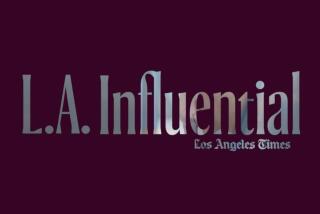PR Boom Isn’t Drum-Beating : Public Relations Industry Expands Beyond Publicity
- Share via
Last September, Ina B. Miller, a one-time $20,000-a-year publicist with the Edye Rome public relations agency in Beverly Hills, quit her job and started her own agency with one client, a telephone and an office in her one-bedroom Van Nuys apartment.
Undaunted, Miller signed seven clients, including local representation of Prentice-Hall Inc.’s professional book division and Avon Products Inc. Her agency--Stuart Co.--has since grossed more than $40,000, enabling it to move into swanky quarters in bustling Westwood. Four employees now handle a business that Miller’s accountant predicts will have revenues of more than $100,000 in its first year.
Often the first to suffer in bad economic times because of its reputation as a business luxury, public relations has thrived recently as the economy has boomed and the industry has broadened its appeal beyond its traditional publicity role.
Business Increased Dramatically
“Employment is up at virtually all agencies,” said Paul H. Alvarez, chairman of New York-based Ketchum Public Relations and chairman of the independent agencies arm of the Public Relations Society of America in New York. “Every company seems to have public relations in some form. . . . Since the last recession, business has increased dramatically across the board.”
Revenues of the nation’s 50 largest public relations firms jumped 24% to $437 million last year from $352 million in 1983, according to a survey released last month by J. R. O’Dwyer Co., a New York-based publisher of trade publications.
Altogether they added more than 800 employees last year, an increase of 14% over 1983. By the end of the century, the number of public relations jobs will nearly triple to about 1 million, predicts Robert Kendall, a University of Florida researcher who analyzed Bureau of Labor Statistics data.
As the field grows, so does its influence. San Jose State University Professor Dennis Wilcox estimates that public relations firms now supply information for more than 50% of stories in the news media. And they often do it with a panache that can rival the razzle-dazzle of Hollywood.
In January, for instance, Century City-based Rogers & Cowan Inc. amassed celebrities,caviar, lasers and levitating dinner table centerpieces to promote two new Ford Motor Co. cars in Hollywood.
Other agencies conduct surveys to help companies or politicians influence government policy or run contests to publicize a product. Washington-based Gray & Co. even produced a television show for the U.S. Chamber of Commerce and Japan to create a positive climate for Japanese Prime Minister Yasuhiro Nakasone’s Jan. 2 meeting with President Reagan.
Growing Across Nation
Although there are no hard figures, the field seems to be growing in all parts of the country, experts say. But perhaps nowhere is the success of the industry’s new glamour more evident than in image-conscious Los Angeles, where nearly every public figure or institution--from lawyers and restaurants to hospitals and ministers--seems to have a public relations agency.
“Businesses now realize they have to communicate to stand out in the crowded, congested marketplace here in Southern California,” said Chris Barnett, an editor at Bulldog, a Los Angeles-based PR industry newsletter.
Hollywood has played a role too, he added. “I’ve talked to insurance agents who feel that a PR person can get them on the Johnny Carson show. They think that PR is some kind of black magic--that a publicist who handles (actress) Morgan Fairchild can weave the same spell for them.”
Billings at the Los Angeles office of New York-based Hill & Knowlton jumped 50% to $3.4 million last year, said Owen Daley, a senior vice president. Rogers & Cowan, the city’s largest agency with about 116 employees, has doubled its revenue since 1980. Yearly billings now exceed $10 million, according to Richard W. Taylor, corporate division president.
Still, not everyone has prospered.
Robert Keith Gray, whose close personal ties with President Reagan have enabled him to build a successful lobbying firm in Washington, with revenue of about $11 million and a staff of 90, stumbled when he tried to repeat his East Coast success in Reagan’s home state.
Folded Operation
Less than 18 months after opening an office in Los Angeles in 1981, Gray folded the operation after it failed to sign a single new client. Bulldog’s Barnett said Gray didn’t give enough support to the local office. A Gray official disagreed.
“I don’t think it was a failure,” said Frank Mankiewicz, a former president of National Public Radio and now executive vice president of Gray & Co. “We closed it because we found that the business we were doing in Los Angeles, we could do (just as well) here” in Washington.
And black-owned agencies complain that they have not participated fully in the PR boom.
“Public relations is growing like crazy but most minority firms are worse off now than they were 10 years ago,” said Sharon Morgan, president of the National Black PR Society and a vice president at Burrell Advertising in Chicago. “Many minority firms are falling further and further behind because they are too small to handle” large corporate accounts.
Publicists were relatively rare until Edward L. Bernays, the 93-year-old nephew of psychiatrist Sigmund Freud, pioneered the field after the turn of the century. A staff member of the U.S. Committee on Public Information in World War I, he studied propaganda techniques and utilized them in the civilian world. He set up shop in the 1920s, and worked for movie magnate Samuel Goldwyn, industrialist Henry Ford and publisher Henry Luce, among others.
‘Last Hired, First Fired’
But it took almost 40 years for public relations to really catch on.
“In the past, public relations people were the last hired and the first fired,” said Walter S. Zeisl, an officer of the Los Angeles Chapter of the Public Relations Society of America. “But after the last recession more and more organizations discovered that public relations can help the bottom line. Public relations is no longer considered a peripheral (business) function.”
Increasingly, companies are relying on public relations experts for crisis management.
Johnson & Johnson marshaled a staff of more than three dozen employees to shape public relations strategy following the Tylenol poisoning scare in October, 1982. Burson-Marsteller advised Union Carbide Corp. after the explosion last Dec. 4 at a Union Carbide chemical plant in Bhopal, India.
Other companies seek to bolster their image to head off problems.
Anheuser-Busch Inc., the St. Louis-based brewer, hired Fleishman Hillard Inc. to develop programs that support anti-drunk driving efforts in order to blunt public criticism of broadcast beer and wine commercials, said John Margaritis, general manager of the agency in Los Angeles.
Demand in High Tech
An explosion of high-tech firms has fueled demand for publicists who can translate the jargon of engineers and explain technological breakthroughs. Demand is so great that Los Angeles-based Rogers & Associates turned down 12 high-tech companies early last year--passing up $720,000 in fees--because it could not hire enough well trained high-tech PR people to service the accounts, Chairman Ronald J. Rogers said.
Public relations has even been embraced by professions that used to avoid publicity.
Law firms, such as Los Angeles-based O’Melveny & Meyers, have hired public relations consultants in recent years in the belief that there may be a more dignified way than advertising to promote their business, according to Warren Christopher, a partner at the O’Melveny firm.
“We don’t have any public relations counsel on any regular retainer but we have sought help on specific projects such as the opening of our New York office,” Christopher said. “But there’s no question that there’s been a major reorientation in the legal profession towards” using public relations to foster “business development.”
Yet while the field has grown to an estimated $1-billion-a-year industry, according to Ketchum’s Alvarez, it still searches for acceptance from a public that understands little about its work, experts say.
Poor Job for Self
“Public relations has not done a very good public relations job for itself,” said William Faith, chairman of the USC public relations department.
Washington Post Managing Editor Meg Greenfield, for example, sent a memo to the Post’s executive editor in the spring of 1982, chiding public relations firms as superfluous middlemen.
“Why should we be in their goddamn memo traffic as exploitable or exploited ‘resources’? “ Greenfield fumed in her memo.
The industry has countered such criticism by trying to raise its standards, trumpeting its successes and rallying its troops.
A “new era” for PR has arrived, in part, because of changes in the news media, said James H. Dowling, president of Burson-Marsteller in New York, the nation’s largest agency.
“The media in this country have grown so large, so fast, that people now can get many more points of view,” Dowling said. “People are much more informed and companies have to be much more sophisticated in their approach to public relations.”
In recent years, newspapers have added feature sections that depend on story ideas pitched by public relations firms. Agencies are also cultivating a growing market of specialty magazines that seek information on new products, scientific discoveries and investments.
Network shows such as NBC’s “Today Show” now include more PR-generated feature segments. Local stations air magazine-type programs that seem to have an insatiable appetite for stories suggested by public relations agencies.
Can’t Measure Benefits
Yet proving its efficacy may ultimately prove to be the Achilles’ heel of the industry as it becomes more competitive, experts say. Unlike advertising, the benefits of public relations are often not measurable in additional sales, they say.
“Those of us in public relations are constantly looking for a way to say, ‘This is the value of what we did for you,’ ” said Taylor of Rogers & Cowan.
“You really can’t put a price on the added credibility,” Taylor continued. “Having someone write favorably about your client is like a third-party endorsement. It’s not like advertising. It’s something money can’t buy.”
Top 10 Public Relations Agencies (Year ended Dec. 31, 1984)
Net % Change Rank Agency Revenues from ’83 Employees* 1 Burson-Marsteller $84,258,000 +32.4% 1,541 2 Hill & Knowlton 69,400,000 +14.0% 1,210 3 Carl Byoir & Associates 30,950,000 +30.0% 573 4 Ruder Finn & Rotman 19,240,000 + 9.0% 350 5 Ogilvy & Mather PR 16,300,000 +25.2% 300 6 Daniel J. Edelman 14,240,194 +39.1% 281 7 Manning, Selvage & Lee 13,428,000 +25.6% 216 8 Fleishman Hillard 11,100,000 +40.3% 137 9 Booke Communications 10,923,670 +23.7% 137 10 Ketchum Public Relations 10,800,000 +28.4% 169
* Employment figures as of Oct. 31, 1984 Source: O’Dwyer Publishing Co.
More to Read
Inside the business of entertainment
The Wide Shot brings you news, analysis and insights on everything from streaming wars to production — and what it all means for the future.
You may occasionally receive promotional content from the Los Angeles Times.










